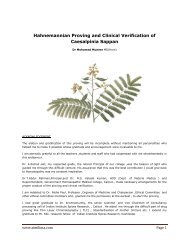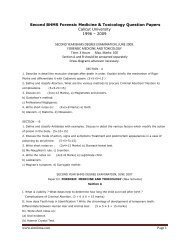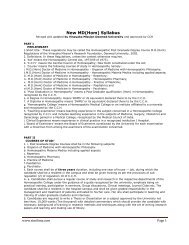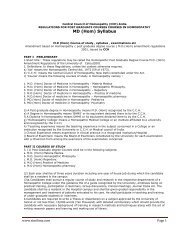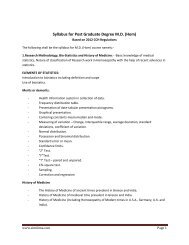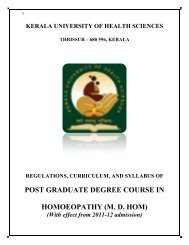Denotations & Old terminologies used in Homopathy - Similima
Denotations & Old terminologies used in Homopathy - Similima
Denotations & Old terminologies used in Homopathy - Similima
You also want an ePaper? Increase the reach of your titles
YUMPU automatically turns print PDFs into web optimized ePapers that Google loves.
Insomnia Insomnia means difficulty <strong>in</strong> fall<strong>in</strong>g or stay<strong>in</strong>g asleep, the absence of restful<br />
sleep, or poor quality of sleep. Insomnia is a symptom and not a disease. The<br />
most common causes of <strong>in</strong>somnia are medications, psychological conditions<br />
(e.g., depression, anxiety), environmental changes (e.g., travel, jet lag, or<br />
altitude changes), and stressful events. Insomnia can also be ca<strong>used</strong> by faulty<br />
sleep<strong>in</strong>g habits such as excessive daytime naps or caffe<strong>in</strong>e consumption.<br />
Insomnia may be classified by how long the symptoms are present. Transient<br />
<strong>in</strong>somnia usually is due to situational changes such as travel and stressful<br />
events. It lasts for less than a week or until the stressful event is resolved.<br />
Short-term <strong>in</strong>somnia lasts for 1-3 weeks, and long-term <strong>in</strong>somnia (chronic<br />
<strong>in</strong>somnia) cont<strong>in</strong>ues for more than 3 weeks. Chronic <strong>in</strong>somnia often results from<br />
depression or substance abuse. Transient <strong>in</strong>somnia may progress to short- term<br />
<strong>in</strong>somnia and without adequate treatment, short-term <strong>in</strong>somnia may become<br />
chronic <strong>in</strong>somnia.<br />
Intertrigo Intertrigo is an <strong>in</strong>flammation of the top layers of sk<strong>in</strong> ca<strong>used</strong> by moisture,<br />
bacteria, or fungi <strong>in</strong> the folds of the sk<strong>in</strong>. The affected areas are usually p<strong>in</strong>k to<br />
brown.If the sk<strong>in</strong> is particularly moist, it may beg<strong>in</strong> to break down. In severe<br />
cases, there may be a foul odor. Intertrigo tends to occur <strong>in</strong> warm, moist areas<br />
of the body where two sk<strong>in</strong> surfaces rub or press aga<strong>in</strong>st each other. It is most<br />
common <strong>in</strong> obese <strong>in</strong>dividuals. This condition may also be seen <strong>in</strong> people who are<br />
restricted to bed rest or <strong>in</strong> those who wear medical devices that may trap<br />
moisture aga<strong>in</strong>st the sk<strong>in</strong>, such as artificial limbs, spl<strong>in</strong>ts, and braces.Intertrigo<br />
is common <strong>in</strong> warm, moist climates.Avoidance of moist, compressed areas is<br />
critical to recovery from <strong>in</strong>tertrigo. Weight loss and frequent reposition<strong>in</strong>g are<br />
often helpful.Affected areas may be cleared with simple steps such as propp<strong>in</strong>g<br />
open sk<strong>in</strong> folds with dry towels or blow<strong>in</strong>g a fan across moist areas. Loose,<br />
unrestrictive cloth<strong>in</strong>g should be worn.<br />
Inveterate Chronic,long seated,firmly established.<br />
Ischuria Retention or<br />
suppression of ur<strong>in</strong>e.<br />
Keloid Cheloid. Hypertrophic scar; Keloid scar; Scar - hypertrophic Keloids are an<br />
overgrowth of scar tissue at the site of a healed sk<strong>in</strong> <strong>in</strong>jury.Keloids occur from<br />
such sk<strong>in</strong> <strong>in</strong>juries as surgical <strong>in</strong>cisions, traumatic wounds, vacc<strong>in</strong>ation sites,<br />
burns, chickenpox, acne, or even m<strong>in</strong>or scratches. They are fairly common <strong>in</strong><br />
young women and African Americans. Keloidosis is a term <strong>used</strong> when multiple<br />
or repeated keloids are produced.Most keloids will flatten and become less<br />
noticeable over a period of several years. They may become irritated from<br />
rubb<strong>in</strong>g on cloth<strong>in</strong>g or other forms of friction. Extensive keloids may become<br />
b<strong>in</strong>d<strong>in</strong>g, limit<strong>in</strong>g mobility. They may cause cosmetic changes and affect the<br />
appearance.Exposure to the sun dur<strong>in</strong>g the first year of the keloid's formation<br />
will cause the keloid to tan darker than surround<strong>in</strong>g sk<strong>in</strong>. This dark coloration<br />
may become permanent. A sk<strong>in</strong> lesion that is:Flesh-colored, red, or p<strong>in</strong>k,<br />
Located over the site of a wound, <strong>in</strong>jury, or other lesion ,Nodular or ridged , The<br />
lesion may itch dur<strong>in</strong>g formation and growth.Discoloration from sun exposure<br />
can be prevented by cover<strong>in</strong>g the form<strong>in</strong>g keloid with a patch or bandaid, and<br />
by us<strong>in</strong>g sunblockers when spend<strong>in</strong>g time <strong>in</strong> the sun. Complications<br />
are Psychological distress if keloid is large or disfigur<strong>in</strong>g , Recurrence of keloid<br />
Discomfort, tenderness, irritation of the keloid<br />
Kleptomania The patient pockets th<strong>in</strong>gs without know<strong>in</strong>g it, or carry them away openly,<br />
because they believe they are mak<strong>in</strong>g use of their own property.<br />
www.similima.com Page 27




